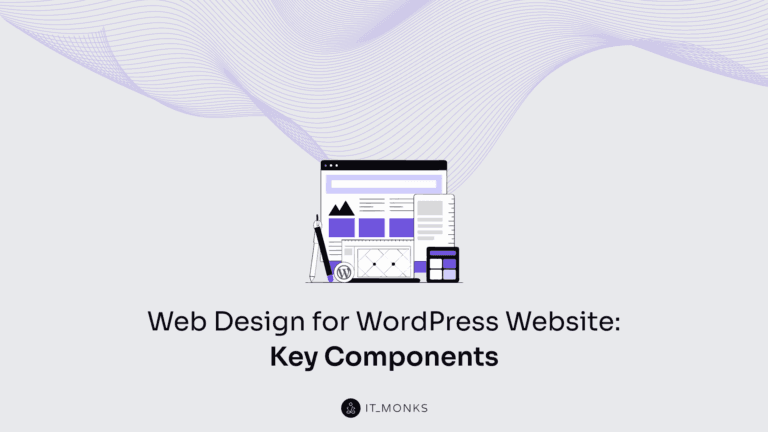What is Enterprise AI?
Table of Contents
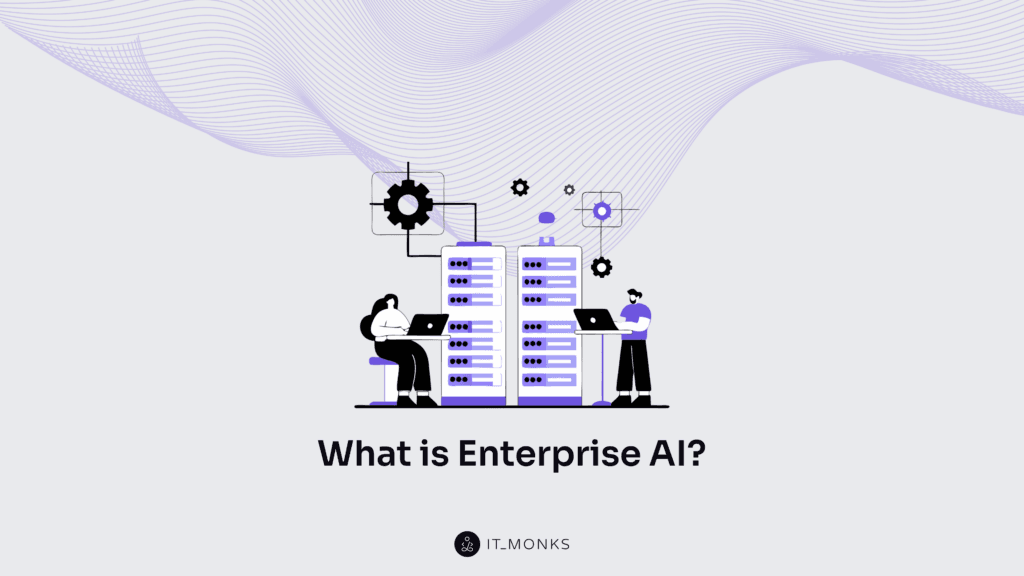
Enterprise AI is the use of artificial intelligence technologies within large business processes, applications, and systems to reduce operational costs, enhance security, streamline processes, gain a competitive edge, and unlock advanced analytics for strategic decision-making.
As AI becomes more integrated into websites, custom web development is essential for its successful implementation. By leveraging tailored solutions, businesses ensure that AI integrates seamlessly with existing infrastructure, optimizes performance, and effectively supports their unique goals.
Unlike traditional AI, which focuses on specific, narrow tasks, such as chatbots for customer service or virtual assistants for scheduling, enterprise AI is designed for extensive, broad automation and optimization across multiple business functions. Enterprise AI integrates deeply with enterprise systems (e.g., ERP, CRM) across various operations, like finance, risk management, marketing, cybersecurity, supply chain, and HR.
AI’s benefits are directly tied to its different types because each type is designed to solve specific enterprise challenges, leveraging data to improve efficiency, accuracy, and decision-making.
- Machine Learning AI automates data analysis, trend forecasting, and anomaly detection, reducing manual workload and improving decision-making efficiency.
- Computer Vision AI automates visual inspections and data extraction, improving quality control in manufacturing, fraud detection in banking, and document processing in legal and healthcare sectors.
- Conversational AI & NLP automate customer support, internal communications, and sentiment analysis, ensuring seamless interactions and reducing response times.
- Generative AI & Large Language Models (LLMs) enable rapid content generation, automated translations, and coding assistance, allowing businesses to innovate faster and scale efficiently.
Successful AI adoption requires a well-structured AI architecture that supports data processing, model training, and seamless integration with enterprise systems. To effectively implement this architecture, businesses must overcome integration, bias, and model performance challenges.
Businesses can overcome these hurdles by leveraging AI integration in custom development and custom web development services. These help organizations build tailored AI solutions that align with their operational needs, ensuring a smoother adoption process, optimized performance, and long-term business value.
How Is Enterprise AI Different from Traditional AI?
Enterprise AI differs from traditional AI in terms of operational costs, security, scalability, integration, and advanced analytics capabilities.
- Enterprise AI reduces operational costs by automating workflows across departments like finance, HR, supply chain, and customer service. It integrates deeply with business systems to optimize payroll and inventory management processes, leading to substantial savings in time, labor, and resources. In contrast, traditional AI primarily automates individual tasks, such as chatbots or virtual assistants, offering only incremental savings in specific areas.
- Enterprise AI employs advanced security features such as Role-Based Access Control (RBAC), audit logs, and private hosting to safeguard sensitive data within a company’s infrastructure. In contrast, traditional AI, often reliant on public cloud APIs, can also utilize audit logs but may be more vulnerable to data exposure. It typically lacks enterprise-grade security measures, such as adversarial testing or granular access controls, which are commonly found in more customized enterprise solutions.
- Enterprise AI leverages predictive models, real-time decision-making, and scalability, providing businesses with a competitive edge by allowing them to adapt quickly to market changes while maintaining operational efficiency. Traditional AI improves specific tasks but lacks the scalability and deep integration necessary to drive a broad, enterprise-wide competitive advantage.
- Enterprise AI enables cross-functional collaboration and end-to-end automation, seamlessly integrating across departments to streamline complex processes and drive organizational efficiency. In contrast, traditional AI is often limited to automating isolated tasks, such as chatbots or recommendation engines, without the ability to optimize workflows or enable coordination across business functions.
Enterprise AI unlocks advanced analytics by enabling real-time, data-driven decision-making and leveraging tools like explainable AI (XAI) to ensure transparency, interpretability, and trust in critical decisions. In contrast, traditional AI provides useful insights for specific applications but lacks the integration, explainability, and capability to deliver enterprise-wide analytics for strategic decision-making.
What Are the Pillars of Enterprise AI?
The key pillars of enterprise AI include data and infrastructure, AI algorithms and models, automation and robotics, and AI governance and compliance.
- Data & Infrastructure. AI relies on vast amounts of structured and unstructured data to learn, recognize patterns, and make predictions. Its foundation is built on efficient data collection, processing, and storage. Technologies such as data lakes, cloud storage, high-performance computing (HPC), and real-time data pipelines ensure that enterprises have the accessibility, scalability, and reliable performance necessary to support advanced AI applications.
- AI Algorithms & Models. AI algorithms are the core intelligence behind AI-driven solutions, determining how data is processed, decisions are made, and insights are generated. Different models serve various functions: Machine Learning (ML) algorithms identify trends and patterns, Deep Learning enables complex recognition in speech, images, and text.
- Automation & Robotics. AI-driven automation transcends traditional rule-based systems by enabling machines to learn, adapt, and optimize workflows. It enhances efficiency across industries by automating customer service with AI chatbots, streamlining data processing through intelligent algorithms, and improving manufacturing processes with AI-powered robotics.
- AI Governance & Compliance. AI governance focuses on bias detection, transparency, data privacy, and regulatory compliance. Enterprises must align AI systems with standards such as GDPR, HIPAA, and relevant ISO/IEC standards to prevent ethical concerns and legal risks. Responsible AI development ensures fairness, builds trust, and enables organizations to harness AI’s potential while mitigating unintended consequences.
What are the Key Components of Enterprise AI?
The key components of enterprise AI are:
- Data infrastructure and AI readiness,
- AI model development and training,
- AI model deployment and scalability,
- AI interpretability and explainability,
- AI security and threat mitigation.
Let’s break down these key components and their importance for enterprise AI functionality.
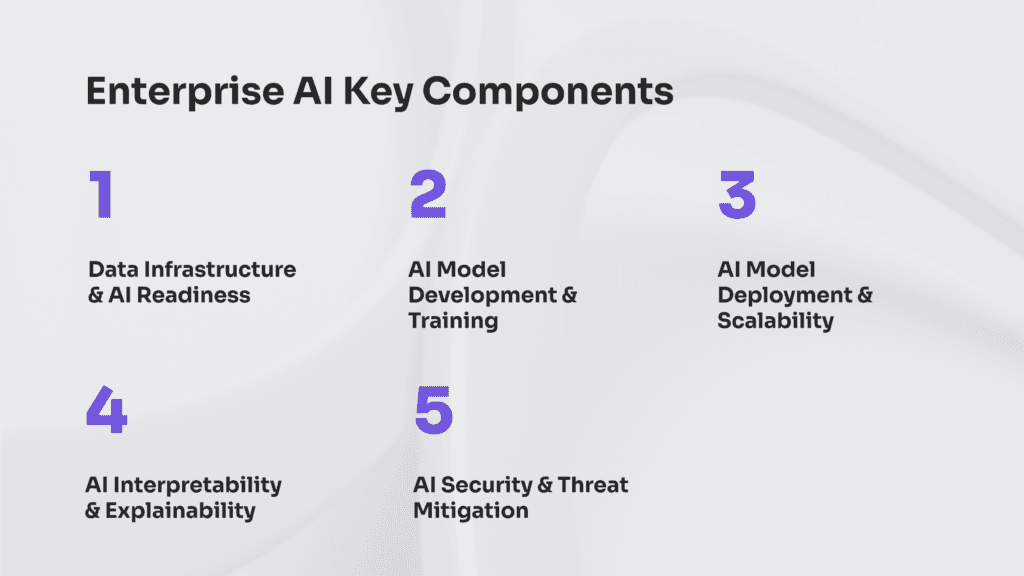
Data Infrastructure and AI Readiness
Data infrastructure is the foundational component of enterprise AI, encompassing hardware, software, networking, and services that enable seamless data storage, management, and access.
Enterprise AI is only as powerful as the data it is built upon. AI models cannot deliver accurate insights or effectively automate complex business processes without an optimized data infrastructure.
Modern enterprises deal with massive volumes of structured and unstructured data from various sources, including customer interactions and operational systems. Big data architectures allow businesses to handle this complexity, leveraging distributed storage and parallel processing to manage large-scale datasets.
Cloud computing platforms such as AWS, Google Cloud, and Microsoft Azure provide on-demand access to scalable storage and computational power, essential for AI workloads.
In addition to storage and computing power, real-time data processing is a key requirement for AI-driven decision-making.
Many enterprises utilize streaming data frameworks like Apache Kafka and Spark to process data as it is generated, ensuring that AI models receive the most up-to-date information.
This is particularly important for use cases like fraud detection, predictive maintenance, and personalized recommendations, where immediate insights can provide a competitive advantage.
Enterprises implement comprehensive data management strategies to maintain data integrity and usability. These strategies include data governance policies to ensure compliance with regulations like GDPR and CCPA, data cleaning and preprocessing to eliminate inconsistencies, and secure data pipelines that facilitate seamless integration between AI models and enterprise systems.
AI Model Development & Training
AI model development is a component of enterprise AI that involves designing, building, and refining AI models to analyze data, recognize patterns, and make intelligent decisions. It involves selecting appropriate learning models, choosing the right learning approach, and applying optimization techniques to enhance performance.
At the foundation of enterprise AI are two key components of AI model development – Machine Learning (ML) and Deep Learning (DL).
- Machine Learning allows AI systems to learn from data and improve predictions without explicit programming. It is widely used in customer analytics, fraud detection, and process automation.
- Deep Learning, a subset of ML, relies on neural networks that mimic the human brain’s structure. It is especially effective for complex tasks like natural language processing (NLP), computer vision, and predictive analytics, making it a powerful tool for enterprises dealing with vast amounts of unstructured data.
The success of an AI model depends not just on the type of learning but also on the learning approach, which makes enterprises choose between:
- Supervised Learning, where models train on labeled datasets to make accurate predictions (used in fraud detection and medical diagnostics).
- Unsupervised Learning, where AI identifies patterns and structures in unlabeled data (useful in market segmentation and anomaly detection).
- Reinforcement Learning enables AI to learn through trial and error, refining decisions based on rewards and penalties (widely applied in robotic process automation and supply chain optimization).
Beyond selecting a learning approach, enterprises must optimize their models for scalability and efficiency.
- Federated Learning is an emerging technique that allows AI models to train across decentralized devices while maintaining data privacy — a key concern in industries like healthcare and finance.
- Transfer Learning, on the other hand, enables enterprises to leverage pre-trained AI models and adapt them to their specific needs, significantly reducing training time and computational costs.
AI Model Deployment & Scalability
AI Model Deployment & Scalability is an enterprise AI component that integrates trained AI models into enterprise systems and ensures they can efficiently scale to meet business demands.
Effective deployment ensures that AI-driven applications function seamlessly across different environments, from internal enterprise systems to cloud-based platforms, while scalability guarantees that AI can handle increasing workloads and adapt to evolving business needs.
Enterprises choose between On-Premise Deployment and Cloud-Based AI Deployment based on security, cost, and computational requirements.
- On-premise deployment provides greater control over data security and compliance compared to cloud-based solutions but requires higher upfront costs than cloud deployment. Businesses may need to invest anywhere from $50,000 to $500,000 or more in servers, networking equipment, security measures, and IT personnel, depending on the scale and complexity of the implementation.
- Cloud-based AI deployment (using platforms like AWS, Google Cloud AI, and Microsoft Azure) provides flexibility, scalability, and cost-efficiency by leveraging distributed computing resources. While cloud AI services typically follow a pay-as-you-go model, costs can range from a few cents per hour for basic instances to thousands of dollars per month for high-performance GPU-based computing, depending on usage, storage, and data transfer requirements.
To streamline AI deployment, enterprises implement CI/CD (Continuous Integration and Continuous Deployment) pipelines for AI models (MLOps), which automate AI solutions’ training, testing, and deployment.
CI/CD automates AI model updates, testing, and deployment. CI ensures frequent code integration and testing, while CD automates deployment to production.
Additionally, containerization technologies like Docker and Kubernetes enhance deployment efficiency by creating portable, scalable AI environments that can run consistently across different infrastructure setups.
For real-time AI applications, enterprises are increasingly adopting Edge AI, which allows AI models to run closer to data sources (e.g., IoT devices, sensors) rather than relying on centralized cloud servers. This reduces latency, enhances real-time decision-making, and improves operational efficiency in manufacturing, healthcare, and autonomous systems.
AI Interpretability & Explainability (XAI)
AI interpretability is an enterprise AI component that focuses on understanding the inner workings of an AI model, while AI explainability aims to provide reasons for the model’s outputs.
Unlike “black-box” models, which make predictions without revealing their internal logic, explainable AI provides insights into how and why an AI system reaches a particular conclusion.
Enterprises rely on Explainable AI (XAI) to enhance decision-making. XAI allows stakeholders to validate AI outputs and mitigate risks associated with biased or flawed predictions.
For example, an AI-driven loan approval system in financial services justifies why a particular applicant was approved or denied. Without explainability, businesses face challenges in debugging AI errors, ensuring fairness, and complying with ethical guidelines.
Enterprises use tools like LIME (Local Interpretable Model-Agnostic Explanations) and SHAP (Shapley Additive Explanations) to achieve AI transparency.
- LIME helps explain individual predictions by approximating complex AI models with simpler, interpretable ones, offering human-readable insights into decision-making.
- SHAP, based on cooperative game theory, assigns important values to each input feature, showing how much each factor contributes to an AI model’s output.
Interpretable models, such as decision trees and linear regression, provide clear reasoning paths, making them easier to audit and understand. However, they may sacrifice accuracy compared to complex AI models.
On the other hand, black-box models, like deep neural networks, excel at pattern recognition but lack transparency, posing challenges for auditing and regulatory compliance.
By integrating explainable AI solutions, enterprises can balance model accuracy with interpretability, ensuring trust, compliance, and effective decision-making.
AI Security & Threat Mitigation
AI security and threat mitigation is a component of enterprise AI that focuses on protecting AI systems from vulnerabilities, attacks, and exploitation that could compromise their functionality and the integrity of business operations.
One significant threat to AI systems is adversarial attacks, where malicious actors manipulate input data to trick AI models into making incorrect predictions. These attacks exploit vulnerabilities in the model by introducing small, often imperceptible changes to input data that can drastically affect AI outputs.
Common types of adversarial attacks include evasion attacks (where an attacker modifies inputs to evade detection) and poisoning attacks (where the attacker injects malicious data into the training set).
To defend against adversarial attacks, enterprises implement defense mechanisms such as adversarial training, where the model is exposed to adversarial examples during training, and input sanitization, which filters out suspicious data.
Another threat is AI model poisoning, where attackers manipulate the training process by introducing biased or incorrect data to compromise the model’s learning. This can distort the model’s behavior, making it unreliable or biased in its predictions.
Enterprises mitigate this risk by using techniques like data validation, continuous model auditing, and employing secure data pipelines that ensure the quality and integrity of training data.
Bias detection and prevention mechanisms ensure AI models make fair and ethical decisions. AI models can inherit biases from the data they are trained on, leading to unfair outcomes, such as discrimination in hiring, lending, or law enforcement applications.
Enterprises employ bias detection tools and strategies, such as diversity audits, fairness constraints, and regular monitoring, to identify and reduce bias in AI models.
To further enhance security, enterprises apply zero-trust security principles (ZTA) to AI systems, emphasizing continuous verification of users, devices, and data interactions rather than assuming any entity can be trusted by default.
ZTA focuses on continuously validating the security of devices, users, and data as they interact with AI systems. This includes verifying access credentials, using strong encryption, and applying granular access controls to ensure only authorized users and systems can influence AI models.
What Are the Types of Enterprise AI?
Enterprise AI encompasses various types, including:
- Machine Learning-Based AI,
- Computer Vision AI,
- Conversational AI & NLP,
- Generative AI & Large Language Models (LLMs).
Depending on their needs and goals, enterprises can use these types of AI separately and together to streamline processes, improve accuracy, and drive innovation across various business functions.
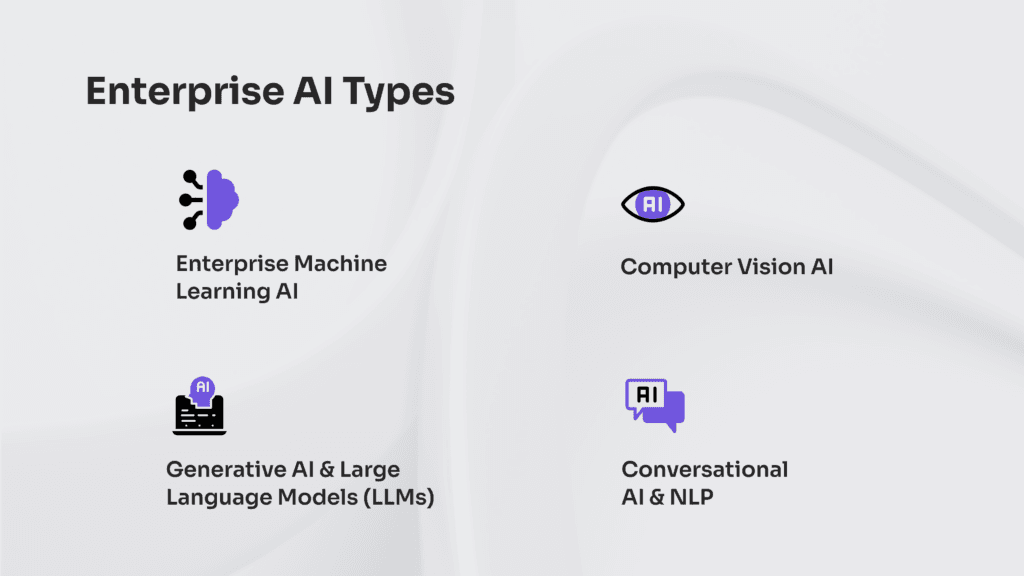
Machine Learning-Based AI
Machine Learning-Based AI is a type of artificial intelligence in which systems learn from data and experience, using algorithms to identify patterns and make decisions based on that data. While machine learning models improve over time without explicit reprogramming, they require human intervention for model training, tuning, and evaluation.
It fuels predictive analytics and forecasts trends for strategic planning and anomaly detection. These capabilities uncover unusual real-time patterns, helping businesses avoid potential issues.
Machine learning also enhances automation by improving decision-making processes, reducing manual errors, and increasing operational efficiency.
Computer Vision AI
Computer Vision AI enables machines to analyze and interpret visual data by leveraging machine learning and deep learning techniques to identify objects, analyze scenes, and perform various visual tasks.
Utilizing Convolutional Neural Networks (CNNs) and Optical Character Recognition (OCR), it transforms industries by automating visual inspections, extracting text from images, and enhancing security systems.
Conversational AI & NLP
Conversational AI is a type of AI that uses Natural Language Processing (NLP) alongside other technologies like speech recognition and reinforcement learning to enable machines to understand, process, and respond to human language in a way that mimics natural conversation.
Conversational AI enhances communication within enterprises, equipping systems with the ability to interpret and generate human language. Technologies such as speech synthesis, chatbots, and sentiment analysis facilitate customer service, virtual assistance, and interactive solutions, improving both internal and external communication.
Generative AI & Large Language Models (LLMs)
Generative AI refers to systems that use deep learning models to generate text, images, audio, and video based on patterns learned from existing data.
Large Language Models (LLMs), such as GPT-3, are a subset of generative AI designed specifically to understand and generate human-like text, with applications in content creation, customer support, and coding assistance.
The core components of generative AI include neural networks, transformers, and large-scale training datasets, which enable models to identify patterns and produce coherent outputs. These models are widely used in tasks such as content generation, automated translation, and personalized recommendations. However, they do not generate “new” content in the human sense but rather synthesize existing data patterns in innovative ways.
AI in Enterprise Operations
AI transforms enterprise operations by enabling automation, improving decision-making, and optimizing various business functions. Its application spans multiple departments, including business operations, finance, cybersecurity, marketing, customer service, and supply chain management.
AI in Business Operations
AI in business operations primarily focuses on enhancing efficiency in task automation, process optimization, resource allocation, and decision-making.
Organizations can streamline repetitive tasks by implementing AI-powered workflow automation, allowing employees to focus on higher-value activities. This reduces operational costs, serves as a decision-support tool rather than a standalone decision-maker, and improves productivity across various departments.
AI is critical in optimizing HR by improving recruitment, talent management, and employee performance tracking. AI algorithms analyze vast amounts of data to identify top candidates, predict employee success, and enhance the overall employee experience, ensuring a more effective and efficient workforce.
However, AI-driven recruitment tools require human oversight to prevent bias and ensure ethical hiring decisions.
AI in Finance & Risk Management
AI enhances fraud detection, credit scoring, and risk assessment in finance and risk management.
- AI fraud detection systems use advanced algorithms, such as decision trees, random forests, neural networks, and anomaly detection techniques, to analyze large datasets in real time. These algorithms identify suspicious patterns and minimize the risk of financial fraud.
- AI credit scoring models enable businesses to assess a customer’s creditworthiness more precisely, incorporating various data points beyond traditional scoring methods.
- AI-driven risk assessment tools help enterprises continuously monitor and evaluate potential financial risks, allowing for proactive mitigation strategies.
AI in Cybersecurity & Compliance
AI enhances threat monitoring, AI-based encryption, and security automation in cybersecurity.
AI-powered systems enable businesses to detect potential security breaches in real time by analyzing vast amounts of data to identify patterns and anomalies indicative of threats. This allows for faster responses and minimizes potential damage.
AI contributes to developing and implementing encryption methods, such as homomorphic encryption and elliptic curve cryptography (ECC). Homomorphic encryption allows computations on encrypted data without decryption, enhancing data security. ECC provides robust security with smaller key sizes, making it efficient for securing sensitive data.
AI reduces human error and enhances overall system resilience by automating processes like patch management, malware scanning, and network monitoring.
AI in Marketing & Customer Service
AI facilitates personalization, recommendation systems, and chatbots in marketing and customer service.
AI personalization tailors marketing campaigns to individual customer preferences, using data to deliver more relevant and targeted content.
AI-powered recommendation systems analyze customer behavior to suggest products or services that align with their interests, driving sales and improving customer satisfaction.
Chatbots provide instant, round-the-clock support in customer service, answering common inquiries and assisting with issue resolution. However, complex customer concerns may still require human intervention.
AI in Supply Chain & Manufacturing
AI enhances supply chain and manufacturing operations through predictive maintenance, logistics optimization, and warehouse automation.
Predictive maintenance identifies equipment issues before they occur, minimizing downtime.
Logistics optimization assists in supply chain planning, demand forecasting, and route optimization, helping businesses adjust stock levels efficiently. Warehouse automation streamlines the storage and retrieval of goods, boosting efficiency and reducing operational costs.
What Are the Types of AI Integration in Enterprise?
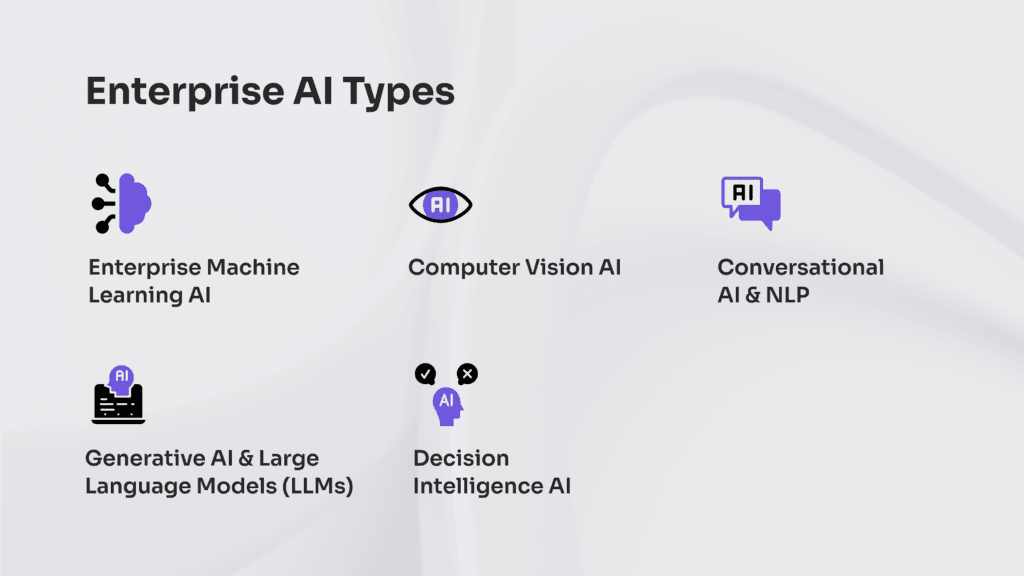
AI integration in the enterprise includes AI-powered CRM and sales automation, AI in ERP and IT management, and AI in legal and compliance automation. AI integration means incorporating artificial intelligence (AI) into existing systems, applications, or processes to enhance their capabilities and efficiency.
These integrations leverage AI technologies to streamline business processes, improve decision-making, and increase department efficiency.
AI-Powered CRM & Sales Automation
AI-powered CRM and sales automation integrate AI with customer relationship management (CRM) systems to enhance and streamline sales processes.
Using machine learning and predictive analytics, AI helps enterprises predict customer behavior, personalize communications, and automate lead scoring and follow-up tasks.
The core features of this integration include AI-driven insights, sales forecasting, and automated customer engagement. This functionality is crucial for improving customer retention, enhancing sales workflows, and increasing revenue.
Solutions like Salesforce Einstein and HubSpot AI use data-driven insights to improve customer interaction, personalize messaging, and automate tasks like lead nurturing. For example, companies using these tools have seen improved customer retention and more efficient sales workflows.
These integrations also seamlessly connect with enterprise web development systems, ensuring smooth data flow between sales teams, CRM systems, and websites.
AI in ERP & IT Management
AI in ERP & IT management involves incorporating AI technologies into enterprise resource planning (ERP) systems to optimize core business functions such as inventory management, financial operations, and resource allocation.
Machine learning, predictive analytics, and intelligent automation streamline operations and empower real-time decision-making.
Key features include inventory forecasting, demand planning, and automated procurement.
These capabilities enable enterprises to react quickly to market fluctuations and improve operational efficiency. Integrating AI into ERP systems, such as SAP S/4HANA and Oracle ERP, can help reduce operational costs, enhance resource management, and improve data accuracy when implemented with the right AI-driven tools and data insights.
AI in Legal & Compliance Automation
AI in legal and compliance automation leverages AI technologies, including natural language processing (NLP), machine learning, and predictive analytics, to automate and improve legal processes. This integration helps businesses comply with regulations, reduce legal risks, and enhance efficiency in routine legal tasks.
AI-driven features like automated contract review, risk identification, and compliance tracking allow enterprises to streamline legal workflows, making them faster and more accurate.
By automating these processes, businesses can significantly reduce non-compliance risk, minimize legal costs, and enhance decision-making.
Solutions like Kira Systems and LawGeex enable legal teams to optimize their workflows, ensuring enterprises can focus on strategic growth while adhering to regulations.
Why Should Enterprises Invest in AI?
Enterprises should invest in AI to achieve cost savings, enhance security, improve operation efficiency, stay ahead of competition, and unlock advanced analytics and insight data for strategic decision-making.
For example, Machine Learning AI analyzes data to detect anomalies, reducing manual effort and improving operation efficiency. Computer Vision AI enhances quality control and fraud detection, ensuring better security. Conversational AI & NLP streamline customer support and internal communication, reducing response times and boosting operational productivity.
AI also strengthens security through advanced threat detection and behavioral analysis, safeguarding sensitive data from unauthorized access. Generative AI & LLMs facilitate faster content creation and innovation, helping businesses scale and stay competitive.
What are AI Implementation Strategies?
AI implementation strategies include Off-the-Shelf AI, Custom AI Solutions, and Hybrid AI-augmented systems.
Off-the-shelf AI solutions are pre-built, ready-to-use tools and applications that businesses can implement with minimal customization.
These solutions are typically less expensive, with pricing ranging from a few hundred to several thousand dollars per month, depending on the scale, features, and usage requirements of the business.
They are also quicker to deploy, often taking anywhere from a few days to a few weeks, depending on the complexity of the integration and the business’s specific needs, as they are designed to meet common needs.
Popular providers of off-the-shelf AI solutions include Microsoft Azure AI, IBM Watson, and Google Cloud AI. The core process involves selecting a solution that meets specific business needs, configuring it, and then integrating it into existing workflows.
The major advantage of this approach is its cost-effectiveness and speed of deployment.
However, the downside is limited flexibility for customization to meet highly specific business requirements.
Custom AI solutions are tailored to address a business’s specific needs. They involve building an AI system from the ground up, often utilizing internal resources or specialized external AI development teams.
Custom AI solutions offer complete flexibility, ensuring the system is designed specifically for the organization’s workflows, data, and objectives.
Core processes include data collection, model training, and iterative testing for optimization.
The biggest advantage of custom AI solutions is that they align with business-specific needs, which leads to higher performance and effectiveness.
However, they tend to require more time and investment upfront and often require specialized knowledge to develop and maintain.
Hybrid AI-augmented systems combine different AI technologies, such as off-the-shelf AI components with custom solutions, to enhance existing processes and balance flexibility with speed.
The integration typically involves using off-the-shelf components where possible (for example, in customer service or data processing) while customizing certain aspects to meet business-specific needs.
Providers of hybrid AI solutions might include major AI platforms like AWS AI, Microsoft Azure, and Google Cloud AI.
The key benefit of hybrid AI is that it offers both the speed of off-the-shelf solutions and the adaptability of custom systems.
The potential downside is the complexity of managing and integrating different AI systems.
When choosing an AI implementation strategy, businesses can leverage AI development frameworks to support and streamline the chosen solution’s deployment, training, and scalability, ensuring optimal performance regardless of the approach.
What are AI Development Frameworks?
AI development frameworks are tools and platforms that facilitate the creation, training, and deployment of AI models.
These frameworks provide essential libraries, tools, and pre-built modules to streamline AI development. They are essential for businesses looking to build customized AI systems or leverage machine learning and deep learning models for various applications, such as data analysis, automation, and prediction.
An AI framework’s main task is to provide a structured environment where developers can easily design and implement AI models. Key functionalities of these frameworks include data manipulation, model training, model validation, and deployment. They often include pre-built algorithms, neural network architectures, and tools for managing large datasets.
Popular providers of AI frameworks include:
- TensorFlow by Google. Known for its flexibility and scalability, TensorFlow is widely used for machine learning and deep learning projects, with tools for training and deploying AI models.
- PyTorch by Meta (formerly Facebook). A popular framework for deep learning, PyTorch is known for its ease of use, dynamic computation graph, and strong community support, making it ideal for research and production systems.
- Keras is a user-friendly deep learning framework built on top of TensorFlow, ideal for fast experimentation. It offers an intuitive API for designing and training neural networks, making it perfect for both beginners and advanced developers.
- Hugging Face Transformers is a library focused on natural language processing, providing pre-trained models like BERT and GPT. It simplifies tasks such as text generation, sentiment analysis, and language translation, with easy fine-tuning for specific applications.
- Scikit-learn is a popular Python library for machine learning, offering tools for classification, regression, clustering, and dimensionality reduction. It is known for its simplicity, efficiency, and seamless integration with other Python libraries.
When choosing an AI framework, businesses should consider the specific AI applications they need, available resources, and compatibility with existing systems.
For instance, TensorFlow and PyTorch are both highly flexible for custom solutions, while AWS and Google Cloud AI may be ideal for businesses looking to integrate AI in a cloud-based environment.
What are the Challenges of Enterprise AI Adoption?
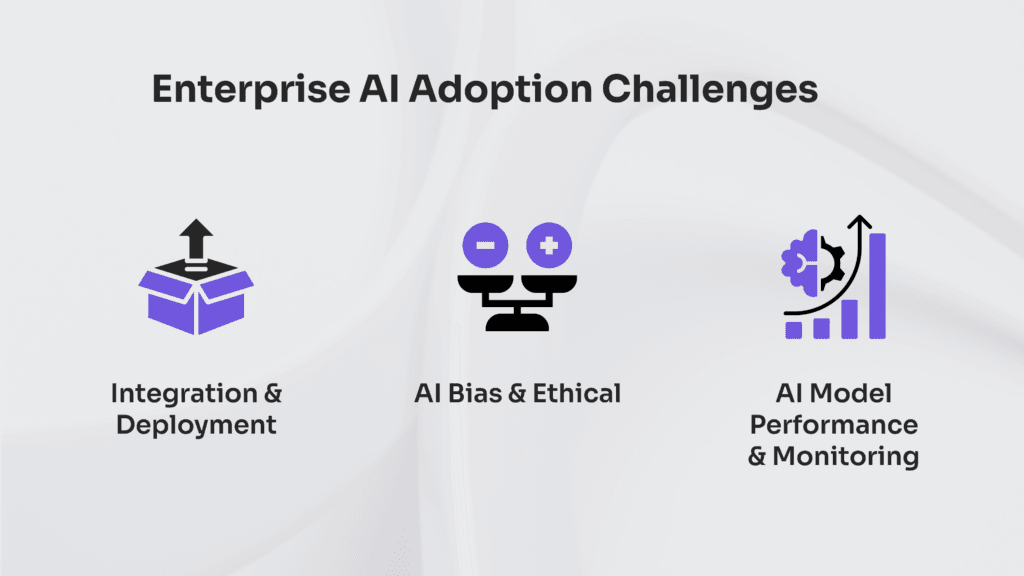
The challenges of enterprise AI adoption include AI integration and deployment, AI bias and ethical concerns, and AI model performance and monitoring.
AI Integration & Deployment Challenges
AI integration and deployment challenges involve embedding AI technologies into existing enterprise systems and workflows. This includes compatibility issues with legacy systems, data management, security risks, and regulatory compliance. Enterprises must ensure that AI tools interact seamlessly with other enterprise technologies while maintaining data privacy and cybersecurity.
Enterprises often face difficulties ensuring that AI tools align with their existing infrastructure, processes, and data structures. Additionally, it can be challenging to adapt AI models to the business’s unique needs and workflows, requiring significant customization and expertise.
Overcoming AI integration challenges is crucial for realizing AI’s full potential within an enterprise. Smooth deployment ensures businesses can operate more efficiently, improve decision-making, and enhance productivity without disrupting existing operations.
Failure to integrate AI properly can lead to inefficiencies, increased costs, and missed opportunities for automation and innovation.
To address these challenges, businesses should:
- Conduct thorough infrastructure assessments before AI implementation.
- Choose scalable and scalable AI solutions that are compatible with existing systems.
- Ensure cybersecurity measures are in place to protect sensitive data.
- Work with AI experts or consultants for seamless deployment.
AI Bias & Ethical AI Challenges
AI bias and ethical challenges refer to the risk of AI systems perpetuating discrimination or unfair practices due to biased data or flawed algorithms. Ethical concerns include privacy, transparency, and accountability in AI decision-making.
If training data is biased or unrepresentative, AI can make unfair decisions, leading to discriminatory hiring practices or unequal customer treatment. The “black box” problem further complicates trust as organizations struggle to interpret how AI reaches decisions.
Unchecked bias can harm a company’s reputation, lead to legal consequences, and erode customer trust. Ethical AI practices are essential for fairness, accountability, and regulatory compliance.
To overcome AI bias and ethical challenges, enterprises should:
- Use diverse and representative datasets for AI model training.
- Conduct regular bias audits to identify and mitigate potential discrimination.
- Adopt explainable AI (XAI) techniques to improve transparency.
- Ensure compliance with AI ethics regulations, such as GDPR and AI Act.
- Collaborate with ethicists, data scientists, and legal experts to develop responsible AI policies.
AI Model Performance & Monitoring
AI model performance and monitoring challenges refer to the difficulty in maintaining AI accuracy over time. AI models can degrade without constant monitoring and updates, leading to poor decision-making.
AI models rely on large datasets to identify patterns, but as business processes, user behavior, or market conditions evolve, those patterns can shift. This phenomenon, known as data drift, reduces accuracy if the model is not retrained.
Failing to monitor and optimize AI model performance can lead to significant losses, inefficiencies, and a decline in user trust. Inaccurate or outdated AI models can make incorrect predictions, leading to poor business decisions, financial losses, and diminished customer experience. Continuous performance monitoring ensures that AI systems remain relevant, accurate, and aligned with evolving business needs.
To prevent performance decline, businesses should:
- Implement continuous monitoring systems that track AI accuracy in real time.
- Use MLOps and AI observability tools like MLflow, Arize AI, or WhyLabs for tracking and logging performance data.
- Conduct A/B testing and periodic model audits to detect performance drops.
- Retrain AI models with fresh data to ensure they adapt to new trends.
- Set up automated alerts when AI performance falls below acceptable thresholds.
Contact
Don't like forms?
Shoot us an email at [email protected]

Send a Project Brief
You need to load content from reCAPTCHA to submit the form. Please note that doing so will share data with third-party providers.
More InformationYou are currently viewing a placeholder content from Turnstile. To access the actual content, click the button below. Please note that doing so will share data with third-party providers.
More InformationYou are currently viewing a placeholder content from Facebook. To access the actual content, click the button below. Please note that doing so will share data with third-party providers.
More InformationYou are currently viewing a placeholder content from Instagram. To access the actual content, click the button below. Please note that doing so will share data with third-party providers.
More InformationYou are currently viewing a placeholder content from X. To access the actual content, click the button below. Please note that doing so will share data with third-party providers.
More Information

